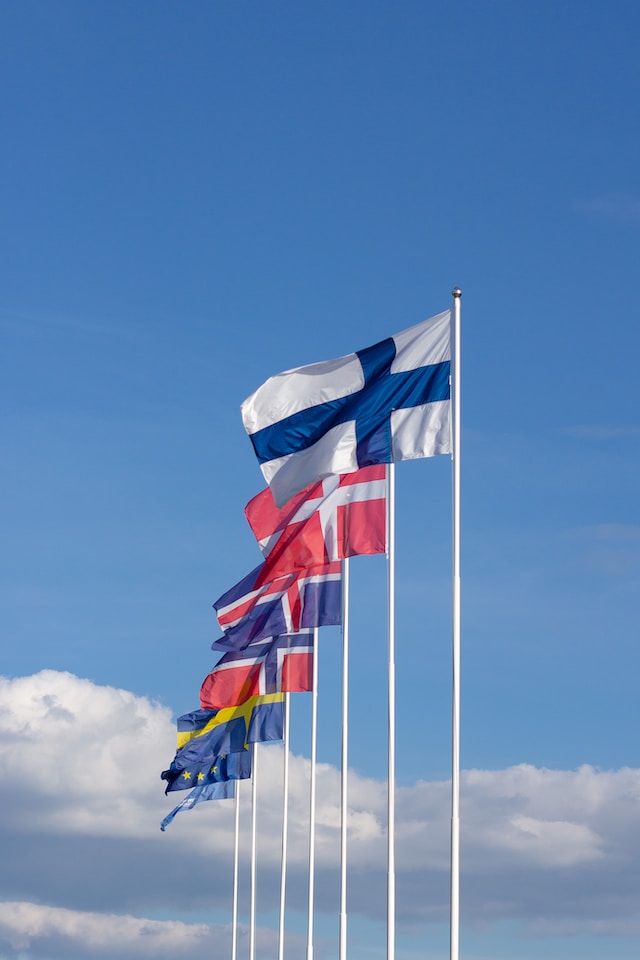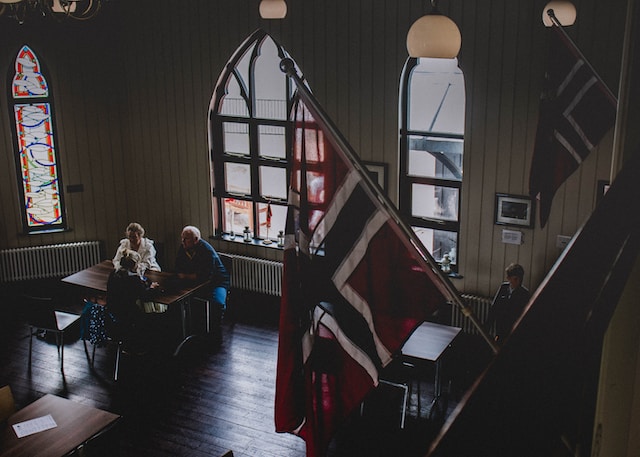
Easiest Scandinavian Language To Learn
Have you been thinking about picking up a new language? If you have been considering learning a Scandinavian language but are still determining what is the most straightforward one to study, we have got all the answers you need!
You would be forgiven for thinking all Scandinavian languages are similarly challenging due to their commonalities and Old Norse origins, often referred to as The Viking Language. Still, some of them are surprisingly more different than most people expect.
Let’s break down the easiest and most difficult Scandinavian languages, examining how they differ and where they share similarities, helping you to discover how these fascinating languages work.

Key takeaways
- Norwegian, Swedish and Danish are easier to learn than Icelandic and Finnish and have less complicated grammar and pronunciation rules.
- Norwegian, Swedish and Danish are North Germanic languages with some ties to English, German and Dutch.
- Icelandic is distantly related to Norwegian, Swedish and Danish, while Finnish is entirely different, making it more challenging to learn.
- Learners tend to find Norwegian easiest to pronounce and Swedish easiest to read.
- Swedish is thought to be the most useful Scandinavian language.
The Easiest Nordic Languages To Learn
Before we delve in, it is important to note that the terms Scandinavian and Nordic are often used interchangeably but actually refer to different groups of countries. Scandinavia refers to Norway, Sweden, and Denmark, while Nordic countries are the three Scandinavian countries, in addition to Finland and Iceland. That being said, many people refer to all five Nordic countries when discussing Scandinavia. To make things more confusing, Finland is a Nordic country, but Finnish is not considered a Nordic language as it bears little to no similarities to the mother tongue of other Nordic countries.
Let’s get into ranking the Nordic languages from easiest to hardest. It is worth remembering that what is deemed the easiest for one person may be different for someone else, as it is dependent on your prior understanding of languages and your learning style.
- Norwegian
- Swedish
- Danish
- Icelandic
- Finnish
Norwegian tends to be the most simple Nordic language to learn for a number of reasons.
- Origins: Norwegian is a Northern Germanic language, meaning it has relatively close roots to Western Germanic languages like German, English, and Dutch.
- Pronunciation: Most Norwegian words are pronounced phonetically, which takes away a lot of the confusion associated with learning new languages. This makes it easier to communicate when you are new to Norwegian, as you generally won’t have to worry about saying the completely wrong thing.
- Grammar: Trying to understand the grammar rules of a new language can make learners feel uneasy. Thankfully, Norwegian is more straightforward than most languages and does not have a huge number of verb conjugations.
- Resources: With a wide selection of online courses, textbooks, and language apps, Norwegian has never been easier to learn. Norwegian movies and television shows have become increasingly popular, providing additional exposure for language learners.
The Easiest Scandinavian Languages To Learn For English Speakers

Next, we will get into the easiest Scandinavian languages to learn, specifically from the perspective of an English speaker, ranked from easiest to hardest.
- Norwegian
- Swedish
- Danish
You might notice that the order from the previous list remains the same, which can be broken down into a few reasons.
- Origins: Norwegian, Swedish, and Danish bear numerous similarities, and much of their grammar and sentence structure are linked. As they all have commonalities with English, Norwegian is the easiest to learn overall, but even more so for English speakers, as many of the language patterns are familiar to learners.
- Vocabulary And Cognates: Cognates are words that share roots, often having a similar spelling and pronunciation that is easy to understand when you understand one of the words. Norwegian and English have a lot of cognates. For example, the English word grass is gress in Norwegian, or rain and regn.
- Norwegians Are Proficient In English: Most Norwegians are fluent in or have a high level of English, making communication between locals and native English speakers easy and giving students plenty of opportunities to practise with people who can explain different aspects of Norwegian to them.
- Standardising Norwegian: The Norwegian government has standardised the written language into two standards, Bokmål and Nynorsk, ensuring consistency amongst language resources as each will follow one of the standards. There is currently no official standard for spoken Norwegian, though many students and teachers follow the standard for Bokmål.
Tired of scrolling through the internet for Norwegian grammar?
Start an organised Norwegian course now.
In order to learn fluent Norwegian, we need to repeat it and speak it several times before our brain learns it.
Learn that in our courses!
Comparing Scandinavian And Nordic Languages
Norwegian, Swedish, and Danish are considered by many to be sister languages, bearing a lot of similarities to one another. Icelandic is quite different, as it is much closer to the Old Norse that the Vikings spoke. Finnish is entirely unrelated to the other four languages and is not a North Germanic language.
Let’s compare Norwegian, Swedish, and Danish first.
Similarities
Sentence structure: Each language follows the subject-verb-object word order.
Gender agreement: All three languages use definite and indefinite articles based on the gender of the following noun.
Vocabulary: Many identical or very similar words between each language.
Differences
Pronunciation: There are often distinct pronunciation differences for many letter sounds in each language.
Spelling: Similarly, spelling patterns can vary to different degrees.
Tone: Danish has noticeable differences in tone during speech, setting it apart from Norwegian and Swedish.
Grammar: The three languages differ regarding verb conjugations and adjective agreement.
Icelandic is best described as a more traditional language than the Scandinavian languages. Here is how it differs from the previous three languages.
Vocabulary: Though they have some shared vocabulary, most words in Icelandic are closer to Old Norse.
Pronunciation: Letter sounds are also more traditional and are quite distinct.
Grammar: Icelandic has much more complicated grammar rules.
Inflection: There is a greater focus on tone and pitch in Icelandic.
Spelling: Spelling patterns in Icelandic are more traditional.
Finally, we have Finnish, which bears no similarities to the other Nordic languages and is a Finno-Ugric language with entirely different origins. As a result, Finnish has unique vocabulary, complex grammar and gender agreement rules, follows a different sentence structure order, and has different phonetic patterns. The only similarity between Finnish and the other Nordic languages is that they all use Latin script.
What Is The Influence Of English On Scandinavian And Nordic Languages?

English has had a noticeable influence on Nordic languages, which can make acquiring new vocabulary significantly easier for English speakers. There are a few reasons for this:
- Many modern words are introduced in English, which are sometimes kept in their original form in Scandinavian languages, such as the word internet. Other times, new vocabulary is slightly adapted to fit the local language.
- Many sectors like business, technology, and education often adapt English terminology.
- Due to the popularity of English media, some English phrases and slang have become widely spoken amongst young people.
Reach fluent Norwegian in only 4 months
Find out your level and how to get started now
Did you know that you don’t need all the Norwegian grammar to speak Norwegian? Just a small part of it. In our classes we use just the necessary grammar. Find out what level you are, and what classes you can take to speak fluently.
Evaluating Language Difficulty
Evaluating the difficulty of a language is challenging, as a range of factors can affect how hard languages are to pick up. For example, Nordic languages may be complex for learners unfamiliar with the Latin script, while English, German, and Dutch speakers may find it easier because of the shared language origins.
The difficulty of a language are individual and will depend largely on the following:
- The language roots or the language family.
- Grammar rules and intricacies.
- The writing script or alphabet used.
- Pronunciation and phonetics.
- Learning opportunities.
- Motivation and reasoning.
- The number of languages you already speak.
- Learning style.
Learn fluent Norwegian in 4 months. Start today.
Did you know that you don’t need all the grammar to speak fluent Norwegian? In our classes we focus just on the necessary vocabulary. So you can learn 3 times faster.
Pronunciation, Reading, And Vocabulary In Scandinavian Languages

Each of these language components can vary between each Scandinavian language.
Pronunciation: Norwegian tends to be the easiest Scandinavian language for learners to pronounce, as many of their sounds are pronounced the same as in English. Words are also pronounced in line with their spelling for the most part.
Reading: Thanks to its relatively simple grammatical rules and phonetic spelling, Swedish is considered one of the easiest Scandinavian languages to learn. English speakers will find their sentence structure familiar and notice some vocabulary closely resembling English words.
Vocabulary: Scandinavian languages have many words that are considerably different from other languages, but they also have many cognates with other Germanic languages and have borrowed or slightly altered modern English words, which can make learning vocabulary more straightforward at times. Many words may be pronounced differently but can still be easily read.
Cultural Aspects Influencing Language Learning
There are a range of cultural elements that can have an effect on the process of learning a language.
- Learning a language is easier if you are interested in a country’s history, culture, music, and media.
- Immersion in a language makes it easier to understand certain expressions and norms used in everyday speech.
- Interacting with native speakers helps to make learners aware of language nuances, such as differences in formal and informal communication.
Learn fluent Norwegian from your level
Check your level now, and find the right course for you
Our classes has native Norwegians who knows how it feels to learn a language, and will do everything to help you.
What Is The Most Useful Scandinavian Language To Learn?

The Scandinavian language that is the most useful to learn may be different depending on the person.
Swedish: Often thought to be the most useful Scandinavian language to learn, as it is more widely spoken than the other and can be helpful for professional situations if you work in the business field.
Norwegian: With pronunciation similar to Swedish and writing linked to Danish, Norwegian can be a good starting point when studying Scandinavian languages, making additional languages easier to learn.
Danish: Denmark has a thriving expat scene and an excellent job market, which can be a great incentive to learn Danish. It is also spoken in Greenland and the Faroe Islands.
What IsThe Most Understandable Scandinavian Language?
Norwegian is widely considered the simplest of the Scandinavian languages for non-native speakers to understand, though Swedish is thought to be only marginally more difficult.
There are several reasons why Norwegian is the most understandable Scandinavian language:
- Norwegian vocabulary is slightly closer to English than the other languages.
- Most words are pronounced as they are spelled, and Norwegian tends to have more simplistic phonetics and sound patterns.
- Norwegian spelling is generally straightforward.
What Is The Most Difficult Scandinavian Language To Learn?

Icelandic is the most challenging to learn out of the Old Norse-rooted languages, while Finnish is considered the most complex of all five main Nordic languages.
Icelandic has not been simplified in the same way that Norwegian, Danish, and Swedish have been and has preserved the complex grammar, spelling patterns, inflections, and pronunciation of Old Norse.
Finnish is complicated to learn for different reasons. It belongs to another language family, has distinct sounds that are difficult to pronounce, and has an elaborate set of grammar rules.
Challenges Of Learning Icelandic
- Grammar: Complicated rules for declensions, conjugations, and noun and adjective agreement.
- Pronunciation: Unfamiliar vowel and consonant sounds and combinations.
- Spelling: Words are commonly pronounced differently from their written form, making spelling tricky for learners.
- Vocabulary: Many words are unlike any other language and may not always have an equivalent in Germanic languages.
- Exposure: Iceland is the only country that speaks the language and has a small population, meaning there are fewer opportunities to be exposed to Icelandic
Challenges Of Learning Finnish
- Origins: Finnish has different roots and has little resemblance to other Nordic languages.
- Agglutinative grammar: Words have numerous different endings with different meanings.
- Sentence structure: With many grammatical cases, sentence structure can be tricky to master.
- Limited resources: Resources to support learning Finnish can be challenging to come by.
What Are The Pros And Cons Of Learning Each Scandinavian And Nordic Language?
| Language | Pros | Cons |
| Norwegian |
|
|
| Swedish |
|
|
| Danish |
|
|
| Icelandic |
|
|
| Finnish |
|
|
Learning A New Scandinavian Or Nordic Language: Some Helpful Tips
- Immerse yourself in the language as much as possible through music, films, and news articles if you are not in the country.
- Converse with native speakers, if possible, either in person or online.
- Take advantage of cognates to build a foundation for your vocabulary.
- Start learning the sentence structure to help you to use your new vocabulary correctly.
- Work on your pronunciation early to avoid confusion when spelling and phonetics differ.
- Some useful resources include language apps like Mondly, italki and Mango Languages or YouTube channels like Learn Norwegian Naturally.
Frequently Asked Questions About Swedish And Norwegian Languages
Which Scandinavian Language Is The Easiest To Learn?
Norwegian is the easiest Scandinavian language to pick up.
What Is The Most Useful Scandinavian Language To Learn?
Swedish and Norwegian are considered the most useful Scandinavian languages to study.
Which Scandinavian Language Is The Most Difficult To Learn?
Icelandic and Finnish are the most difficult Nordic languages to learn.
Learn fluent Norwegian in 4 months. Start today.
Did you know that you don’t need all the grammar to speak fluent Norwegian? In our classes we focus just on the necessary vocabulary. So you can learn 3 times faster.
